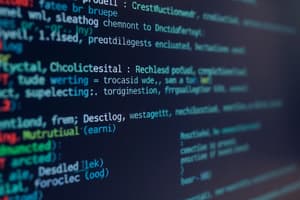Podcast
Questions and Answers
What best describes the main function of human protocols?
What best describes the main function of human protocols?
- To facilitate specific messages and actions among humans. (correct)
- To govern network communication for devices.
- To ensure secure transmission of data over the Internet.
- To define the format and order of digital data.
Which characteristic is NOT associated with computer network protocols?
Which characteristic is NOT associated with computer network protocols?
- Descriptive etiquette for human interaction. (correct)
- Format (syntax and semantics) definition.
- Specific actions taken upon message receipt.
- Order of messages sent and received.
What is a key difference between human and network protocols?
What is a key difference between human and network protocols?
- Human protocols solely deal with computers.
- Network protocols require user interaction to function.
- Human protocols focus on technical specifications.
- Network protocols involve actions taken based on events. (correct)
In network protocols, what does the term 'syntax and semantics' refer to?
In network protocols, what does the term 'syntax and semantics' refer to?
Which of the following is an example of a specific message in human protocols?
Which of the following is an example of a specific message in human protocols?
What role does 'order of messages' play in network protocols?
What role does 'order of messages' play in network protocols?
Which component is essential for defining actions taken on message transmission in network protocols?
Which component is essential for defining actions taken on message transmission in network protocols?
What concept is related to the structure of the Internet in communication networks?
What concept is related to the structure of the Internet in communication networks?
What type of networks can include both residential and institutional access?
What type of networks can include both residential and institutional access?
Which of the following is a characteristic of WiFi wireless access points?
Which of the following is a characteristic of WiFi wireless access points?
What technology is typically used to connect to the headend or central office in wired connections?
What technology is typically used to connect to the headend or central office in wired connections?
Which of the following devices is commonly combined in a single box for home networks?
Which of the following devices is commonly combined in a single box for home networks?
What is the typical speed of wired Ethernet connections mentioned?
What is the typical speed of wired Ethernet connections mentioned?
Which of the following best describes mobile access networks?
Which of the following best describes mobile access networks?
Which network is primarily responsible for content delivery in the discussed architecture?
Which network is primarily responsible for content delivery in the discussed architecture?
What is a common feature of enterprise networks compared to home networks?
What is a common feature of enterprise networks compared to home networks?
What is the local action performed during forwarding?
What is the local action performed during forwarding?
What does the forwarding process utilize to determine the correct output link for packets?
What does the forwarding process utilize to determine the correct output link for packets?
Which of the following best describes the role of the routing algorithm?
Which of the following best describes the role of the routing algorithm?
In the context of packet forwarding, what does header value refer to?
In the context of packet forwarding, what does header value refer to?
How is the action of forwarding characterized in the content provided?
How is the action of forwarding characterized in the content provided?
Which of the following actions is NOT part of the forwarding process?
Which of the following actions is NOT part of the forwarding process?
What does 'local forwarding table' refer to in packet forwarding?
What does 'local forwarding table' refer to in packet forwarding?
What role does the destination address play in the context of packet arrival?
What role does the destination address play in the context of packet arrival?
What is the main characteristic of Frequency Division Multiplexing (FDM)?
What is the main characteristic of Frequency Division Multiplexing (FDM)?
How does Time Division Multiplexing (TDM) manage user communication?
How does Time Division Multiplexing (TDM) manage user communication?
In packet switching, what is the impact of excessive congestion?
In packet switching, what is the impact of excessive congestion?
What is a trade-off associated with using packet switching?
What is a trade-off associated with using packet switching?
How many users can be simultaneously active in circuit-switching with a 1 Gbit/s link?
How many users can be simultaneously active in circuit-switching with a 1 Gbit/s link?
What technique is mentioned as a way to mimic circuit-like behavior in packet switching?
What technique is mentioned as a way to mimic circuit-like behavior in packet switching?
Which condition describes ideal use of packet switching?
Which condition describes ideal use of packet switching?
What is a potential downside of using packet switching technology?
What is a potential downside of using packet switching technology?
What is the transmission delay for a packet of length L bits at a link transmission rate R?
What is the transmission delay for a packet of length L bits at a link transmission rate R?
In a store-and-forward packet switching system, which of the following statements is true?
In a store-and-forward packet switching system, which of the following statements is true?
If a packet of size $10$ kbit is transmitted over a link with a capacity of $100$ Mbit/s, what is the one-hop transmission delay?
If a packet of size $10$ kbit is transmitted over a link with a capacity of $100$ Mbit/s, what is the one-hop transmission delay?
What is the total transmission delay for a packet that travels through two hops or links?
What is the total transmission delay for a packet that travels through two hops or links?
Which of the following best describes the concept of 'link capacity'?
Which of the following best describes the concept of 'link capacity'?
What does 'L bits' refer to in the context of packet switching?
What does 'L bits' refer to in the context of packet switching?
What happens when a router receives a packet in a store-and-forward system?
What happens when a router receives a packet in a store-and-forward system?
If the link transmission rate R is increased, what effect does this have on the transmission delay for a packet of size L?
If the link transmission rate R is increased, what effect does this have on the transmission delay for a packet of size L?
Flashcards are hidden until you start studying
Study Notes
Human and Network Protocols
- Protocols are sets of rules that govern communication.
- Human protocols are rules for communication among people, like "what's the time?" or "I have a question."
- Network protocols are rules for communication between computers, like connecting TCPs.
Communication Network Structure
- The Internet consists of network edges and a network core.
- Network edges include hosts, access networks, and physical media.
- Network cores include the internet structure, packet/circuit switching, performance metrics (loss, delay, throughput), protocol layers, and security aspects.
Access Networks
- Access networks connect devices to the internet.
- Access networks include: residential, institutional, mobile, and enterprise networks.
- Home networks can use both wireless (WiFi) and wired connections.
- Home networks often use a single box for wired and wireless connections.
- Home networks have routers and firewalls to manage internet traffic.
Forwarding and Routing
- Forwarding moves arriving packets from a router's input link to its appropriate output link.
- Routing determines source-destination paths taken by packets.
Packet Switching
- In packet switching, data is broken down into smaller packets and transmitted individually.
- Packet transmission delay is the time it takes to transmit a packet into a link.
- Packet switching uses a store-and-forward method, where the entire packet must arrive at a router before it can be transmitted on the next link.
- Packet switching can experience queueing delays if packets arrive at a router faster than they can be transmitted.
Circuit Switching
- Circuit switching reserves a dedicated path for communication.
- Each user in a circuit-switching network can transmit at a maximum rate determined by the allocated band.
Packet Switching vs. Circuit Switching
- Circuit switching limits the number of users due to fixed allocated bandwidth.
- Packet switching allows for more users because it statistically multiplexes bandwidth.
- Packet switching can lead to congestion and packet loss.
Advantages and Disadvantages of Packet Switching
- Packet switching is more efficient for data that is sent in bursts.
- Packet switching is simpler to implement than circuit switching.
- Packet switching can lead to congestion and packet loss.
- Protocols are needed to ensure reliable data transfer and congestion control.
Studying That Suits You
Use AI to generate personalized quizzes and flashcards to suit your learning preferences.




